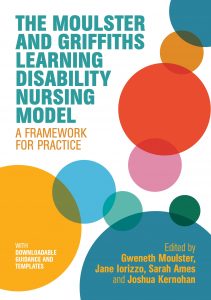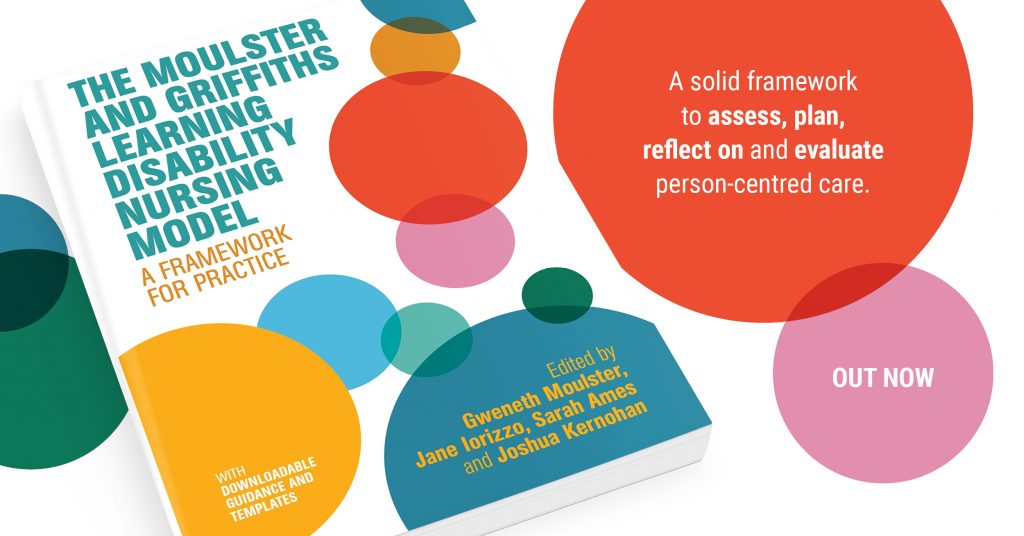The Moulster and Griffiths Learning Disability Nursing Model: A Framework for Practice was co-written and edited by Gwen Moulster, Jane Iorizzo, Sarah Ames and Joshua Kernohan. Below is a blog about the book by author Jane Iorizzo.
The Moulster and Griffiths Learning Disability Nursing Model; a framework for practice is written collaboratively, mostly by learning disability nurses working in the field. The editors, Gwen, Jane, Sarah and Joshua, invited others, who had used the model in practice, studies or teaching to contribute their experiences in the hope that this would provide a greater insight for the reader. The editors wanted the book to reflect the diversity of the model and its tools by demonstrating how widely it can be implemented. Nursing peers, colleagues with a special interest, a student nurse, lecturers, family members and a person who has a learning disability were all invited to contribute, and in doing so have added incredible value to the book.
Right at the beginning, while first planning how they wanted the book to look, Gwen, Jane, Sarah and Joshua decided that finding a way to include a family story or, even better, input from a person who has a learning disability was really important to them. Nursing discussions, professional viewpoints and practice examples are interesting, yes, but who of us wouldn’t want to hear from the people at the receiving end of the care we perceive as good. This is when Sally and her parents, Lauretta and Chris, agreed to help.
Although asking Sally, Lauretta and Chris to be part of writing the book was a resounding yes from the start, it was a little tricky to work out how best to apply their experiences to the focus of the book; a nursing model. Although having access to learning disability nursing support at intervals throughout Sally’s life, they would not have necessarily recognised the use and benefits of different nursing models and practices over that time – they would have had other priorities, concerning their family’s wellbeing! Priorities which the other authors in the book argue are supported by the model and the way it supports a learning disability nurse to practice. So it was decided that Sally, Lauretta and Chris would be asked to simply share their story, while the editors, using learning boxes and prompts, encourage the reader to think about where they might have suggested nursing care, and which parts of the Moulster and Griffiths model for learning disability nursing practice would have helped them to implement it.
Sally is the youngest of three siblings. She is a happy, healthy young woman with years of practice in the performing arts under her belt, a comfortable home and a happy marriage. Sally was also born with Down’s syndrome, a diagnosis which was delivered to her parents in the worst possible way; via telephone with the added recommendation of booking a termination for the following day! Lauretta and Chris’s introduction to their daughter’s diagnosis lacked support, understanding or compassion from professionals.
Although Sally’s story is a very happy one, in their chapter, her parents do describe other difficulties experienced throughout her life. A lack of accessible social care meaning difficulties in accessing day to day support. Fears of not opting for education options that would help Sally to achieve her full potential due to a lack of available information. Worries that there is not enough support available to ensure that Sally receives accessible sex education. Chris states that many times his family have had to “fight the system rather than be supported by it”, and Lauretta makes reference to how nice it would have been to have had learning disability nursing support around legal matters such as mental capacity. She recalls the first learning disability nurse who had contact with Sally, and how nice it was to have support from someone who “wasn’t afraid of Sally’s needs, or of offering to help.”
The chapter takes the reader through Sally’s many past achievements – stage performances, a beautiful wedding, moving into her own home – and shares Lauretta and Chris’s worries for the future. Their recognition that, as Sally grows older, the likelihood of her needing support around her health will increase. They share their hopes that any workers will be person centred and appreciate the fact that the Moulster and Griffiths model for learning disability nursing practice is just this. Lauretta explains that she would feel confident that a nurse with specialist skills, using this model, would be “doing things in the best way possible”. The chapter ends in a very person-centred way, with a statement of excitement and gratitude from Sally, and a photograph she has kindly shared from her wedding day.
You might like to read Jane’s other blog: It’s Time for a Person-Centred Approach to Learning Disability Nursing
 The Moulster and Griffiths Learning Disability Nursing Model
The Moulster and Griffiths Learning Disability Nursing Model
A Framework for Practice
Edited by Gweneth Moulster, Jane Iorizzo, Sarah Ames and Joshua Kernohan
Describing the Moulster and Griffiths nursing model, this book demonstrates how learning disability nurses can use it in practice. It provides an effective framework to assess, plan, reflect on and evaluate person-centred care, considering the complex needs of people who have learning disabilities, their families and their carers.
If you would like to read more articles like this and get the latest news and offers on our health care books, why not join our mailing list? We can send information by email or post as you prefer. You may also be interested in liking our Social Work, Mental Health and Health Care Facebook page.
